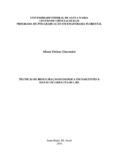| dc.creator | Giacomini, Idiane Fátima | |
| dc.date.accessioned | 2019-08-22T19:07:18Z | |
| dc.date.available | 2019-08-22T19:07:18Z | |
| dc.date.issued | 2016-02-26 | |
| dc.identifier.uri | http://repositorio.ufsm.br/handle/1/17997 | |
| dc.description.abstract | The present work had the purpose to evaluate the real potential of techniques in actions of ecological restoration in springs areas and riparian, searching to evaluate the dynamics of natural restoration in sixs springs under many different restorative treatment, in the city of Itaara, Meriodional Plateau of Rio Grande do Sul state.Were two through the achievement of floristic research of regenerating extract, between the years of 2014 and 2015, evaluated through of phytosociological parameters, diametric distribution, analisys of relation between springs with the species by DCA (rectified correspondence review) and indexes of diversity and similarity. The work also searched to evaluate the early behavior of six native forest species, introduced by direct sowing in a patch of riparian, where the species Schinus terebentifolius Raddi, Psidium cattleianum Sabine, Eugenia uniflora L., Cupania vernalis Cambess., Prunus myrtifolia L.(Urb.), Zanthoxylum rhoifolium Lam, was sown, evaluating the parameters, germination percentage, survival rate, and relative grown rate (TCR(%)). For the dynamics of the ecosystem structure of springs study, the results show of the natural regeneration comes to expanding in all springs, once the number of subjects and species gradually increased during the monitoring, proving of that areas have a little of resilience. . Is observed of the regenerative potential is centered in near remaining forest in each area of springs. For isdirect seeding,E. uniflora andC. vernalis, presented results for the germination, survival and development field. The rest os species didn’t have results for germination. The results reflects the need for attention to the lotof seeds and soil conditionsand management. That concludes of the techniques of simple isolation has the potential for ecological restoration through natural regeneration, provided that there is resilience. Direct seeding requires further experimental efforts to be validated for the study region. It is recommended of that strategies in the management for the preservation of riparian and springs are seen in a landscape context, taking into consideration not only the ecological aspects, but the economics and social too. | eng |
| dc.language | por | por |
| dc.publisher | Universidade Federal de Santa Maria | por |
| dc.rights | Attribution-NonCommercial-NoDerivatives 4.0 International | * |
| dc.rights.uri | http://creativecommons.org/licenses/by-nc-nd/4.0/ | * |
| dc.subject | Regeneração natural | por |
| dc.subject | Semeadura direta | por |
| dc.subject | Recursos hídricos | por |
| dc.subject | Áreas de preservação permanente | por |
| dc.subject | Natural regeneration | eng |
| dc.subject | Direct sown | eng |
| dc.subject | Water resources | eng |
| dc.subject | Permanente preservation areas | eng |
| dc.title | Técnicas de restauração ecológica em nascentes e matas ciliares, Itaara, RS | por |
| dc.title.alternative | Ecological restoration techniques in springs and riparian areas, Itaara, RS | eng |
| dc.type | Dissertação | por |
| dc.description.resumo | O presente estudo teve por objetivo avaliar o potencial de técnicas de restauração ecológica em nascentes e matas ciliares, buscandoavaliar a dinâmica da regeneração natural em seis nascentes sob diferentes tratamentos restaurativos, no município de Itaara,Rebordo do Planalto Meriodional do Rio Grande do Sul. Foram realizados dois levantamentos florísticos do estrato regenerante, no ano de 2014 e 2015,avaliados através de parâmetros fitossociológicos, distribuição diamétrica, análise da relação das nascentes com as espécies pela DCA (análise de correspondência retificada) e índices de diversidade e similaridade. O estudo também buscou avaliar o comportamento inicial de seis espécies florestais nativas, introduzidas via semeadura direta num trecho de mata ciliar, ao qual as espécies Schinus terebentifolius Raddi, Psidium cattleianum Sabine, Eugenia uniflora L., Cupania vernalis Cambess.,Prunus myrtifolia L.(Urb.), Zanthoxylum rhoifolium Lam. Avaliou-se o percentual de germinação, taxa de sobrevivência, e taxa de crescimento relativo (TCR(%). Quanto à dinâmica da estrutura ecossistêmica das nascentes em estudo, os resultados indicam que a regeneração natural vem se expandindo em todas as nascentes, uma vez que o número de indivíduos e espécies aumentou gradativamente no decorrer do monitoramento, demonstrando que as áreas apresentam certo grau de resiliência. Observa-se que o potencial de regeneração está centrado pelos remascentes florestais próximos das nascentes. Quanto à semeadura direta, E. uniflora e C. vernalis, apresentaram resultados de germinação, sobrevivência e desenvolvimento a campo. As demais espécies não tiveram respostas. Tais resultados, retratam a necessidade de atenção ao lote e vigor de sementes e às condições de solo e manejo. Conclui-se que o isolamento da área apresentou potencial para restauração ecológica através da regeneração natural, desde que haja resiliência. A semeadura direta requer maiores esforços experimentais para ser validada para a região do estudo. Recomenda-se que as estratégias na gestão para conservação das matas ciliares e nascentes sejam vistas num contexto de paisagem, levando em consideração não só aspectos ecológicos, mas também sociais e econômicos. | por |
| dc.contributor.advisor1 | Rovedder, Ana Paula Moreira | |
| dc.contributor.advisor1Lattes | http://lattes.cnpq.br/5274469660466638 | por |
| dc.contributor.referee1 | Monteiro, Josita Soares | |
| dc.contributor.referee1Lattes | http://lattes.cnpq.br/4124767739817947 | por |
| dc.contributor.referee2 | Schenato, Ricardo Bergamo | |
| dc.contributor.referee2Lattes | http://lattes.cnpq.br/4043277579467500 | por |
| dc.creator.Lattes | http://lattes.cnpq.br/7273460342956695 | por |
| dc.publisher.country | Brasil | por |
| dc.publisher.department | Recursos Florestais e Engenharia Florestal | por |
| dc.publisher.initials | UFSM | por |
| dc.publisher.program | Programa de Pós-Graduação em Engenharia Florestal | por |
| dc.subject.cnpq | CNPQ::CIENCIAS AGRARIAS::RECURSOS FLORESTAIS E ENGENHARIA FLORESTAL | por |
| dc.publisher.unidade | Centro de Ciências Rurais | por |



